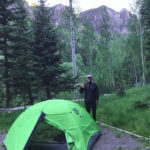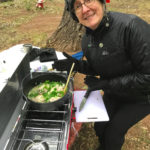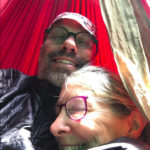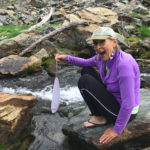We felt a sense of mourning earlier this month as we drove the final miles of our seemingly endless road trip—click here to see the final map of our travels. We know we are spoiled when we tell you that we felt eight months was not enough to do more than a “survey” of the western national parks. Part of us wishes we could just keep on going, as there is still so much more to do. We’ll be starting a very different adventure on February 2.
In total, we drove 24,000 miles, hiked over 750 miles, camped 134 nights, and had more picnics, campfires, and outdoor baths than we can count. We met so many interesting people and were blown away by the beauty and grandeur of our country. Our Oboz and Merrell hiking boots were terrific but the soles are already worn down. Far from feeling that we have now “done” the west, we feel like we’ve only just begun (apologies to The Carpenters).
So, it may go without saying that we heartily recommend finding a way to get out there and experience the beauty in whatever way you can. One park at a time, or more. Hike, bike, kayak, walk, whatever!
Why We Absolutely Loved Camping
We understand that many people don’t love camping and wonder why we do. But there you have it. We camped as much as possible for eight months, and never got tired of it. Sleeping in our tent was cozy and invigorating: we loved the fresh air, the simplicity, the moonlight, and the sounds of birds, rushing streams, and animals. We stayed in an AirBnB or hotel three or four nights a month, on average, to make it easier to get errands done, access wifi, and talk to our family. We greatly preferred staying at AirBnBs than hotels and never had a negative AirBnB experience—we stayed in lots of interesting places and met some new friends.

One of the top things in our favor was the weather. When you camp on the east coast, you’re more likely to contend with bad weather, which can definitely make you cranky and scream that you’ll never camp again. Packing up wet stuff is NO FUN. But that didn’t happen to us on this trip. The weather was outstanding from mid-May to mid-October, so we never had to bail out of camping due to weather. In October, we camped in Sequoia National Park at 6700 feet above sea level in California’s Sierra Nevada Mountains, and it started to get very cold at night (about 20° F outside the tent, 35° in the tent). After that, we were still able to camp well into December by moving to lower elevations and southward where the temperatures were warmer (including Pinnacles, Channel Islands, Joshua Tree, Death Valley, and Big Bend National Parks).
Most of our camping was “car camping”—which means we were able to drive up (rather than hike or paddle) to our campsites. While there are opportunities to camp for free on some public lands, we actually preferred to camp in campgrounds (cost: $7-35/night) where there were usually some people around, as well as basic amenities like some kind of toilet and drinking water. Most campsites also provide a picnic table, a fire ring, some sort of grill, and a patch of ground level enough to pitch a tent. Almost all of our campsites were beautiful and quiet, and often we could do day hikes or paddles right out of our site without getting in the car. Since we didn’t have reservations, we’d have to be very strategic to get a site during “high season,” but ultimately, we always succeeded.
We also did some backcountry camping—backpacking, kayaking, or canoeing into a primitive site with few or no amenities. Backcountry camping allows you to be in the wilderness and experience the self-sufficiency of carrying everything you need on your back or in your boat. We did six backcountry camping adventures—through Labyrinth Canyon on the Green River, and in Rocky Mountain, Glacier, North Cascades (twice), and Olympic National Parks—and would love to do more.
Let’s Talk About Gear
Behind any great trip, there’s great gear. As a wrap-up, we thought we’d write a brief homage to the gear that made our trip successful. We hope our experiences can also help you find your own adventure.
Driving. We loved our Ford F150 pickup truck. Most of the people we met who were doing long-term travel had RVs of various sizes and configurations. Some were really huge towed a car behind. Everyone seemed to be very excited about their RVs. But we never regretted our decision to travel by truck.
What we loved: high clearance four-wheel drive took us to awesome unpaved places by fording streams and climbing gorgeous, winding roads where longer vehicles were not allowed; the ability to camp just about anywhere; cooking and sleeping outside in the fresh air instead of in a vehicle; the visibility from sitting up high while driving; the ever-comfortable sofa-like front seat; all the room in the cab and truck bed to stow gear for camping, backpacking, kayaking, and biking, and the perfect set-up we constructed to help us stay organized (thank you Jeff B!).
Not so lovable: driving and parking in cities (fortunately, we didn’t do this very much); the gas mileage (we averaged 19+mpg); and too many electrical features which drained the battery down if we didn’t drive for a few days.
Tenting. We started out with a perfectly wonderful Sierra Design three-person backpacking tent from the 1990s, but we also wanted a smaller, lighter tent that would be even better for backpacking. So, we invested in a Nemo Galaxi two-person tent. We totally fell in love with the little Nemo tent, and it became our tent of choice except on very cold nights, since the Sierra Design tent is slightly warmer because it has less screening. Bear in mind that these tents are just for lying in bed or sleeping, because you can just barely sit up in them. We don’t suffer from knee or back problems, so we don’t mind sleeping close to the ground. We also brought along a “screen tent” for hanging out—more on that below.
What we loved about our Nemo: it’s super-smart: fast and easy to assemble; lightweight; the straight (rather than curved) zippers are easy to use and less susceptible to failure; two doors and vestibules make it easy to exit the tent without crawling over the other person.
Sleeping. Most people associate tent sleeping with achy, sleepless nights. We’ve definitely had those experiences too, in the past. So, we spent months figuring out how we’d sleep comfortably for eight months in a tent. After all, if you aren’t getting a good night’s sleep, you’ll get cranky, tired, etc., which is not a recipe for happy camping.
Before we set off on our trip, we bought several different air mattresses and tried them out in our house. In the end, we chose the Therm-a-Rest Neo-Air DreamTime sleep system, and we were very happy with it. When we car camped, we topped it off with a “down coupler,” real sheets, pillows, and a comforter—which made it as cozy and comfortable as our own bed at home. When we were backpacking, we used just the lightweight inflatable air mattress inserts with our sleeping bags without the cushy foam sleeves—which was not as comfortable but definitely good enough. (We’ve decided we hate sleeping bags so we’re working on an alternative for our next adventure.)
What we loved: The comfort! When we used the foam sleeves, our bed was more comfortable than the “real” beds we encountered in hotels and AirBnbs. It was versatile for both car camping and backpacking. It allowed us to sleep together and share our body warmth on chilly nights (super important, and very nice!). Sometimes we left the mattresses blown up in the back of the truck so we could set up quickly in a new campsite.
Not so lovable: The little battery-powered air pump that came with it was slow and obnoxiously noisy. We ended up using our own lungs to blow up the mattresses…which was not fun but was tolerable since it doesn’t take very long and we didn’t have to do it every day (since we typically stayed at the same campsite for several days).
Cooking. Cooking outdoors is fun if you have the right equipment. We had separate cooking set-ups for car camping and for backpacking. For car camping, we had a Camp Chef two-burner cook stove, and we brought along basic cooking and serving supplies from home. The stove is designed to attach to a small (16 ounce) propane canister, but we decided early on that we could do better. These little canisters don’t last very long if you’re using them twice a day; you worry about running out of gas; the cost adds up (about $3-4 each); and they can’t easily be refilled or recycled, so most people just throw them out. Lorrie was particularly annoyed by that last point; we found a few places recycle used canisters, puncturing them so they could be melted down and made into something else, which seems like an enormous waste of energy. (Grrrr….) So, we bought a 15 lb. propane tank (just like you would connect to your gas grill at home). Camp Chef sells an adapter hose that was a bit quirky at times, but it was a major improvement. A full tank cost less than $20. We only refilled it twice over eight months, and it still has gas in it.
What we loved: cooking and dining al fresco every night, and learning to cook one-dish meals on the fly, that were simple, delicious, and easy to clean up after, working with whatever ingredients we had. This was made possible by our Yeti cooler that kept food cold for several days; our full box of spices from home; and the dutch oven, manual coffee grinder, and French press coffeemaker that Dylan and Stephanie gave us—all of which we used every day. (Thanks, guys!)
Lighting. Lightweight camping headlamps are a necessity for reading, washing up, and moving around the campsite at night. We also used a Barebones USB-rechargeable lantern and a small, inflatable Luci solar light.
Screen tent. Our 10 ft.-square REI screen tent allowed us to escape from insects, and occasionally, from intense sun or rain. We didn’t need it very much, but we were grateful for it when we did.
Other gear we loved:
Eno hammock. Everyone seems to have these hammocks now, and once you try one, you’ll see why. Elise bought us a “double nest” so we could lie in the hammock together and we totally loved it. (Thanks Elise!)
REI Flexlite camp chairs—lightweight (<2 lbs.), portable, easy to assemble, and very comfortable
MSR Windburner backpacking stove system. This stove totally revolutionized the way we eat while backpacking. It’s highly efficient and lightweight and eliminated the need to carry pots, pans, dishes, and dish washing stuff. We now eat dehydrated meals when we backpack—they taste surprisingly good (much better than they used to), and are super easy, affordable and convenient.

“Personal hydration systems.” We are total converts to the use of personal hydration systems. We used them in our daypacks for day hikes, and switched them to our backpacks for longer trips. Bob has a 3-liter Deuter and Lorrie has a 2-liter Camelback. This usually was enough water for a long day hike…but if we ran out we used our….
MSR Hyperflow Water Filter. We took this along whenever we backpacked. You should never drink unfiltered water, even if it’s running swiftly and looks clean. You never know what lies upstream—i.e., animal scat or a carcass of some kind. Most water is potable once you filter it with this portable filter.
Sun shower. It’s basically just a black rubber bag that has straps on the top for hanging and a plastic shower head on the bottom for showering. You fill the bag up with water in the morning, lay it in the sun, and hope the water is still warm when you return from hiking. When it works, it’s very enjoyable. When it doesn’t—such as when it’s cloudy or cold—well…then you have a decision to make. Bob doesn’t mind bathing in cold streams and lakes, even when they’re fed by snow melt, but Lorrie couldn’t stand it. Everyone has their own tolerance for not bathing and you count on your partner to let you know if you’re really overdue.
Audiobooks and podcasts. Good audiobooks and podcasts really help you get through the long drives. Some of our favorite podcasts were Reveal, More Perfect, The Axe Files, Revisionist History, Slow Burn, Code Switch, RadioLab, Reply All, and Fresh Air. Our favorite audiobooks explored themes of race in America: Between the World and Me (written and read by Ta-Nehisi Coates, this is a must-listen for everyone); Their Eyes Were Watching God (Zora Neale Hurston—with an amazing read by Ruby Dee); No Name in the Street (James Baldwin); and Tears We Cannot Stop (written and read by Michael Eric Dyson). We also listened to “travel books” recommended by friends: John Steinbeck’s Travels With Charley, William Least Heat-Moon’s Blue Highways, and Lolita, by Vladimir Nabokov, which we never really thought of as a travel book. (Did you?) Jeremy Irons’s reading is captivating and appropriately sleazy. It’s horrifying, but we were glued to it until we just couldn’t take it anymore and wanted it to stop. And yes, there is quite a bit of travel in the book, but we’re still dubious about describing it as a travel book.
Mobile hotspot. Most national parks and forests don’t have cell service or wifi—except when you get up to the top of a mountain, you sometimes can catch a cell signal and all your stuff comes pouring in. We’d sometimes drive to town to get cell service, and if we had a good signal, we would use our mobile hotspot to connect our laptop to the internet and post a blog. It was really handy. Lorrie also would sometimes connect to it on the highway to research our upcoming destinations.
Beer. Nothing tastes better after a good long hike! We subjected this theory to rigorous research and it really held up!
A shared spirit of adventure and great gear made this the trip of a lifetime. If you have any specific questions about beautiful natural places in the western states or you’d like advice about your next adventure, give us a shout and we’ll be happy to tell you more.
We’re leaving the States on February 2 for a new adventure and plan to continue blogging and posting pictures. In our next blog, we’ll tell you about our plans.






















Wish I’d said hello when you were in town! Great to hear about your adventures, and the pictures are lovely. I hope South America is just as wonderful–good luck, you two!
Hope
Thanks Hope! Sorry we missed you. Hope all is well!
You two are awsome and exemplary. I thoroughly enjoyed every posting I read and lived vicariously your adventures. Thanks for sharing such an amazing experience. Best wishes for your new trip, I will be looking forward to future postings. Mainly, take care – you do not need anybody telling you to have fun and enjoy each other’s company — you surely know how to do that!
Hi Magdalena. We’re hoping you and Camilo will join us at some point this year. It was great to see you in Seattle and would be fun to travel together.
Hi Magdalena! Thanks so much for writing. I hope you and Camilo and family are doing well! We so enjoyed seeing you in Seattle—thanks so much! Any chance to meet somewhere this year? We could have a lot of fun! ??
Jeff Brown my friend of nearly 40 years has included me in your adventure. I feel lucky to be along for the ride.
Hi Jeremy. Great to meet you! We’re so glad that Jeff has gotten out to see you this last year. He’s a good friend, and we feel fortunate to have him in our lives.
Thank you for taking the time to share your journey, all the ins and outs and ups and downs. I loved the detail provided on the gear and how you made your days happen. You gave yourselves a lot of joy in these travels and gave some of that joy to the rest of us! Please keep writing and keep safe!
What a great adventure! I love the blog and really love your adventurous spirits!! Looking forward to the next chapters. Kerri